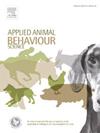The ability to interpret affective states in horses' body language is associated with experience with animals
IF 2
2区 农林科学
Q1 AGRICULTURE, DAIRY & ANIMAL SCIENCE
引用次数: 0
Abstract
In light of an increasing interest in the human ability to read equine emotions, Braun et al. (2024) recently showed that horse-experienced individuals performed better in interpreting affective states in horses’ body language than horse-inexperienced individuals. Further, individuals with a high emotion recognition ability performed better in interpreting horses’ affective states than individuals with a low emotion recognition ability. The authors operationalized the ability to interpret affective states from horses’ body language by means of the behavior identification test (BIT). In the BIT, participants are presented with 32 photographs of horses that express different affective states and, for each photograph, are asked to choose which out of eight affective states the depicted horse expresses in its body language. In the present study, we scrutinized the replicability and the robustness of these findings. Further, we tested the idea that a better ability to interpret affective states in horses’ body language is associated with experience with animals in general but even more so with horses in particular. We did so by employing the design by Braun et al. (2024) in a novel sample, expanded by a number of quasi-experimental variables (i.e., animal/horse contact while growing-up; current pet/horse ownership; contact with animals/horses during work). We directly replicated the effect reported by Braun et al. (2024) that horse-experienced individuals outperform horse-inexperienced individuals in the BIT. Further, we demonstrated that a higher emotion recognition ability was associated with a better ability to interpret affective states in horses’ body language. Moreover, we found strong evidence in support of the notion that a better ability to interpret affective states in horses’ body language is associated with experience with animals in general and, more strongly, with horses in particular, be it during childhood or currently. We call future research to test the idea that the ability to interpret affective states in horses’ body language can be trained through contact with horses or other animals by means of experimental designs to identify a potential causal relation.
解读马肢体语言中情感状态的能力与与动物相处的经验有关
鉴于人们对人类读懂马情绪的能力越来越感兴趣,Braun等人(2024)最近表明,有马经验的人在解读马的肢体语言情感状态方面比没有马经验的人表现得更好。此外,高情绪识别能力的个体比低情绪识别能力的个体更能理解马的情感状态。作者通过行为识别测试(BIT)将从马的肢体语言中解读情感状态的能力操作化。在BIT测试中,研究人员向参与者展示了32张表达不同情感状态的马的照片,并要求他们在每张照片中选择所描绘的马用肢体语言表达的8种情感状态中的哪一种。在目前的研究中,我们仔细检查了这些发现的可重复性和稳健性。此外,我们测试了这样一种观点,即更好地解读马的肢体语言情感状态的能力与一般动物的经历有关,但对马的经历更是如此。我们在一个新样本中采用了Braun等人(2024)的设计,并通过一些准实验变量(即,动物/马在成长过程中的接触;目前拥有宠物/马匹;工作期间与动物/马接触)。我们直接复制了Braun等人(2024)报告的效应,即有马经验的个体在BIT中表现优于没有马经验的个体。此外,我们证明了更高的情绪识别能力与更好地解释马的身体语言中的情感状态的能力有关。此外,我们发现了强有力的证据来支持这样一种观点,即更好地解释马的肢体语言情感状态的能力与一般动物的经验有关,尤其是与马的经验,无论是在童年还是现在。我们呼吁未来的研究来测试这样一种观点,即通过与马或其他动物的接触,通过实验设计来识别潜在的因果关系,来训练解读马肢体语言情感状态的能力。
本文章由计算机程序翻译,如有差异,请以英文原文为准。
求助全文
约1分钟内获得全文
求助全文
来源期刊

Applied Animal Behaviour Science
农林科学-行为科学
CiteScore
4.40
自引率
21.70%
发文量
191
审稿时长
18.1 weeks
期刊介绍:
This journal publishes relevant information on the behaviour of domesticated and utilized animals.
Topics covered include:
-Behaviour of farm, zoo and laboratory animals in relation to animal management and welfare
-Behaviour of companion animals in relation to behavioural problems, for example, in relation to the training of dogs for different purposes, in relation to behavioural problems
-Studies of the behaviour of wild animals when these studies are relevant from an applied perspective, for example in relation to wildlife management, pest management or nature conservation
-Methodological studies within relevant fields
The principal subjects are farm, companion and laboratory animals, including, of course, poultry. The journal also deals with the following animal subjects:
-Those involved in any farming system, e.g. deer, rabbits and fur-bearing animals
-Those in ANY form of confinement, e.g. zoos, safari parks and other forms of display
-Feral animals, and any animal species which impinge on farming operations, e.g. as causes of loss or damage
-Species used for hunting, recreation etc. may also be considered as acceptable subjects in some instances
-Laboratory animals, if the material relates to their behavioural requirements
 求助内容:
求助内容: 应助结果提醒方式:
应助结果提醒方式:


